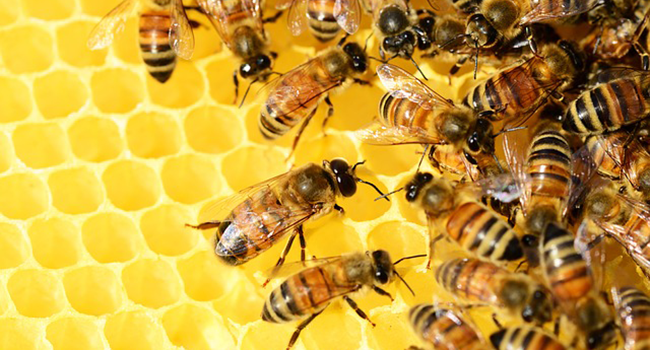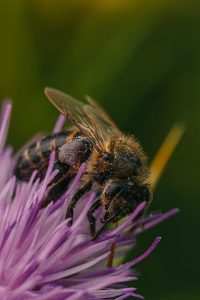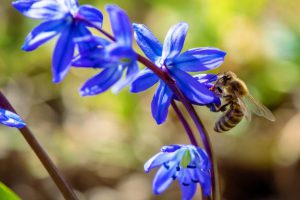By: Mark Winston
Bees teach us that leaders best serve society when they promote core ideals that unite rather than divide.
These are tough times for diversity in the Western world, with democracies convulsed by the linked trio of systemic racism, a copious flow of refugees from impoverished and war-torn regions, and rising xenophobia. Ironies abound, particularly in the United States, a country whose ostensible values celebrate tolerance yet in practice is spinning the rich diversity of its citizens toward conflict between “us” and “them.”
One of the hallmark benefits of diversity is providing perspectives through different lenses. The two of us have been involved in a writing project focusing our quite different personal backgrounds in the direction of bees. One of us is a Jewish entomologist originally from Brooklyn but raised outside of Cleveland, Ohio, while the other is a poet, daughter of a Hindu Brahmin father and a Muslim mother, born in India and raised in various small towns across Canada. Our collaboration has itself benefited from that diversity, drawing on Mark’s research interest in bees stretching back over a 40-year career, and Renée’s lifelong interest in poetry inspired by bees as muse.
Together we’ve been metaphorically listening to what we might learn from bees about the nature of diversity. This is a particularly compelling time to view bees from this merged sensibility, as they are in deep trouble. Forty percent or so of managed honey bee colonies die each year, replaced at great cost by beekeepers, and the thousands of unmanaged bee species living in our fields, farms and forests are similarly in precipitous decline. The factors underlying this apian tragedy are now well-known: a synergistic interaction between pesticide impact, diminished diversity and abundance of floral resources, and diseases and parasites.
Honey bees colonies are particularly instructive because they are highly social, like us, and also quite diverse, made up of stepsister workers with the same queen mother but 15-20 drone fathers that inseminate the queen early in her life. The hive population may reach 50,000 individuals, but each subgroup of sisters expresses its own characteristics.
Colonies appear homogeneous at first quick glance, but after long hours in apiaries, composed of thousands of instances opening up hives, harvesting honey, preparing bees for Winter, and inspecting colonies in the Spring, colony diversity becomes palpable. Even superficially the worker bees show visibly different colors, with some almost jet black while others may be yellow or brown. And, there is substantial behavioral variance between stepsisters, particularly in the ages or likelihoods at which they perform particular tasks in the hive. Some, for example, may be more likely to forage for nectar or pollen, others begin rearing larvae at younger ages, while another group of sisters tends toward defending the nest.
“Bees do not cloak reality with lies or fake news.”
Research has measured the benefits of this diversity, including increased colony effectiveness at finding and collecting food, heightened levels of disease resistance and improved hive-level temperature regulation. But perhaps most significant is resilience, with diverse colonies able to respond quickly and effectively to challenges such as predator attacks or opportunities such as a field of nectar-producing flowers coming into bloom.
Diversity alone is not sufficient; honey bees must communicate with each other rapidly and thoroughly if these diverse subgroups are going to successfully weave their individual activities into common purpose. To be immersed in a honey bee colony is to be awash in a constant flow of information, with messages transmitted chemically through pheromones, physically through vibration and sound, and visually and tactically through dances and ritualized behaviors.
Notably, honey bee workers spend considerable time in the hive listening to each other, picking up information about what needs to be done within the colony and what might be happening outside that requires their attention. Each bee has its own perspective, based on experience and genetic background, but it is the sum of these points of view that provides the full set of information about how the hive’s collective wisdom might best focus on work that promotes colony well-being.
Honey bees also provide an important metaphor for leadership. The queen is not a monarch in the human sense. Rather, through her pheromones that circulate through the nest she sends a message to the worker bees that commitment to their colony is key to survival. Instead of commander-in-chief, we might think of her as conscience-in-chief, reminding the bees that the society they hold in common is more important than their individual differences.
There also is much to be learned about diversity from wild bees, which mostly build solitary nests in the ground or in hollow twigs. Many inhabit our cities, and do well in urban areas because they thrive in the in-between, folding themselves precisely into interstitial habitat cracks, foraging on the great variety of flowers present in metropolitan areas.
Myriad small but highly varied urban micro-ecosystems are surprisingly hospitable to bees, from backyard gardens to empty lots, parks to roadsides. As a result, cities host among the highest levels of bee diversity and abundance of any global habitat. But it’s not a one-way relationship; nature in the city would not exist without the pollinating power of bees, and the bees could not thrive without the nesting habitats and floral resources provided in cities.
“Honey bee workers spend considerable time in the hive listening to each other, picking up information about what needs to be done within the colony and what might be happening outside that requires their attention.”
Wild bees are doing quite a bit better in cities than on our farms, where their diversity could provide an ecological pollination service instead of the current system that requires managed honey bee colonies to be trucked in during bloom, often from thousands of miles away. Large-scale contemporary agriculture, with its heavy dependence on pesticides and extensive single-crop acreages, is a harsh environment for wild bees. Yet, when sustainable agricultural practices with reduced pesticide use and mixed cropping are implemented, wild bee populations recover sufficiently to pollinate crops, so that their diversity becomes of direct benefit to us.
Bees, of course, are not us, but paying attention to how bees manage and express diversity provides insights into what we lose when diversity falls prey to xenophobia. Like honey bees, we benefit from variation, providing flexibility and resilience to human societies. Honey bees also remind us that an unfettered, constant flow of reliable information is critical for decision making. Bees do not cloak reality with lies or fake news, but rather pass around pure information unhindered by politics, so that their nest mates can make wise decisions that benefit their community.
Bees also teach us that leaders best serve society when they promote core ideals that unite rather than divide. We can be quite different from each other politically, culturally, socially and spiritually, but only if we share a vision that celebrates differences while emphasizing our underlying common values.
From wild bees we learn another important trait of both biological and human systems: diversity begets diversity, creating stable, durable communities. The small and unnoticed wild bees can be powerful healers of disrupted habitats, while for us the daily work of a diverse citizenry creates the healthiest communities.
We, like nature, thrive when diversity blooms. Listening to the bees should remind us that diversity is more in our self-interest than bashing those different from us, because it’s those differences that make our nations, like bees, the most durable and successful.
For correspondence:
Mark L. Winston, FRSC, Professor and Senior Fellow Morris J. Wosk Centre for Dialogue, Simon Fraser University, 3309-515 W. Hastings St., Vancouver, B.C. V6B 5K3 Canada
778.782.7894; winston@sfu.ca
Mark L. Winston is a scientist and Senior Fellow at Simon Fraser University’s Morris J. Wosk Centre for Dialogue, in Vancouver, British Columbia. Renée Sarojini Saklikar is a lawyer and poet and recently completed a three year term as the first Poet Laureate in Surrey B.C. Together they have co-authored the recently published book Listening to the Bees.









